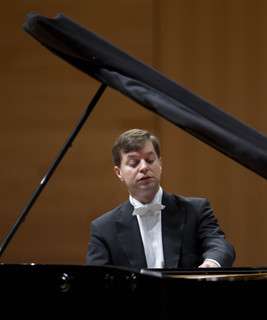|
Back
Nagano’s Bruckner Misses the Mark Montréal
Maison symphonique de Montréal, Place des Arts
10/13/2011 - & October 15, 2011
Pierre Boulez: Mémoriale
Ludwig van Beethoven: Piano Concerto No. 2 in B-flat major, opus 19
Anton Bruckner: Symphony No. 4 in E-flat major “Romantic” (Nowak edition, version 1878-1880)
Timothy Hutchins (Flute), Till Fellner (Piano)
Orchestre symphonique de Montréal, Kent Nagano (Conductor)

T. Fellner (© Allen McInnis)
Kent Nagano and the Orchestre symphonique de Montréal (OSM) performed three “Bs” on Thursday evening—not the usual trio of Bach, Beethoven and Brahms, but Boulez, Beethoven and Bruckner. The concert opened with the most recent work, Boulez’s Mémoriale for solo flute and eight instruments from 1985. This seven-minute composition, according to the program notes “is a rescoring of the final, five-minute episode of the 37-minute …explosante-fixe… (explosive-fixed), which features a flute interacting with MIDI software and a 24-piece chamber orchestra. The significance of ‘explosive-fixe’ (a term Boulez borrowed from André Breton’s prose poem Nadja) derives from the large-scale plan of this work in progress.” The flute, eloquently played by OSM principal flutist Timothy Hutchins, opens the composition on a soft note and carries much of the musical line. The other instruments–strings and two horns–reverberate tightly but delicately after the flute and evoke pastoral sounds reminiscent of Messiaen. It ends with a note by one of the horns disappearing softly as if into the mist. The OSM is featuring the music of Boulez in five concerts this season, but all works are tidbits. Why couldn’t we hear a longer work?
Till Fellner, a familiar soloist with the OSM, then performed Beethoven’s Piano Concerto No. 2. He has recorded the Fourth and Fifth with this orchestra. Fellner delivered an elegant, classical reading typical of this Viennese artist, but I would have preferred the brightness and sparkle of a Kovacevich or the sincerity and poetry of a Perahia. Fellner takes few risks, but he did put a bit of muscle into Beethoven’s cadenza.
Unlike the Bruckner Ninth that Nagano and the OSM gave last December, their performance of the Fourth missed the mark. It was often coarse and strident and sometimes felt rushed. Crescendos and diminuendos were too abrupt. It lacked the magic, majesty and fullness of the Bruckner sound. In the first movement particularly, the sound of different sections of the orchestra seemed to dissolve into each other. The horns did well with their hunting calls, and the strings often rendered a coherent, luminous sound, but the trumpets and trombones overpowered much of the performance. What was most lacking was the underlying unity and feel for the architectural structure necessary to produce and sustain Bruckner’s famous “cathedrals of sound”. I don’t think the new hall’s acoustics did anything to help. The sound was hard and dry, and the woodwinds were all but inaudible from the centre of the main floor.
Earl Arthur Love
|